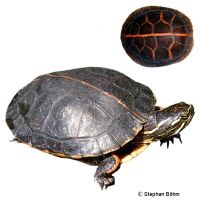Southern Painted Turtle (Chrysemys picta dorsalis)
| Southern Painted Turtle Chrysemys picta dorsalis | |
|---|---|
| Name | Southern Painted Turtle |
| Name Lat. | Chrysemys picta dorsalis |
| Family | Pond Turtles & Box Turtles |
| Family lat. | Emydidae |
| Order | Turtles |
| Order lat. | Testudines |
| Origin | SE-USA |
| Habitat | Rivers, ponds |
| Diet | Fish, insects, plants |
| Humidity | 60-80 % |
| Behavior | ♂ aggressive |
| Keeping | Individual, harem |
| Care Level | Moderate |
| Reproduction | Oviparous |
| Housing | Aquaterrarium |
| Life Span | 15-20 years |
| Protection | EU Annex B |
| Metric Units | |
| Size | 10-15 cm |
| Temperature | 25-30 °C |
| Temperature Local | 35-40 °C |
| Housing Size | 80 x 40 x 40 cm |
| US Units | |
| Size | 4"-6" |
| Temperature | 77-86 °F |
| Temperature Local | 95-104 °F |
| Housing Size | 30" x 15" x 15" |
Distribution and habitat
The range of the southern ornate turtle is the southeastern United States, from Texas to Alabama. They live in slow-moving and stagnant waters with soft bottoms and dense vegetation, as well as sheltered basking areas on the shores.
Maintenance
Minimum dimensions for the aquaterrarium, according to the size and number of animals
| floor space for 1-2 animals: 5PL x 2,5PL (L x W) | Water level: 2PB |
The carapace length (PL) and carapace width (PB) is measured on the largest animal. For each additional animal, increase the footprint by 10%, and for the 5th animal and larger, increase the footprint by 20%. A terrarium of e.g. L 80 x W 40 x H 40 cm is recommended, which should be placed in a quiet and vibration-free place.
It needs a spacious, well structured aquaterrarium. The water part, with a soft, muddy substrate, should be structured with roots, aquatic plants and larger stones (visual barriers and hiding places), some of which reach the water surface. In addition, they need a land part for drying, which is equipped with a soft, muddy-sandy bottom ground, with plants and roots, and with sunny places. To maintain water quality, a powerful filter with low flow is recommended, as well as frequent water changes.
| Water Temp | lighting | Sunny | |
| Summer | 20-28 °C | 12-14 hrs. | 35-40 °C |
| winter (2-3 months) | 8-15 °C | 6-8 hrs |
They need daily UV irradiation and sunny places with radiant heat.
Diet
The diet consists of insect larvae, snails, earthworms, mealworm larvae, shrimp, fish pieces, scraped beef or liver, supplemented with pelleted or freeze-dried ready-to-eat food. Frozen food is also well accepted. Be sure to offer lettuce, dandelion, endive and aquatic plants (e.g. waterweed). Young animals should be offered food daily, adults twice a week. Regular addition of minerals and vitamins is important
A regular and varied diet promotes health and prevents deficiency symptoms.
Reproduction and breeding
Males have a concave ventral carapace and a much thicker tail than females. The anal opening of the male is closer to the tip of the tail than in the female.
A small, sandy patch of land is required for oviposition (1-18 eggs). The incubation period is 61-77 days at a temperature of 28-30 °C
Life expectancy can be 15-20 years.
Species protection
The animal population must be reported in writing to the competent authority immediately after the start of keeping. Subsequently, all arrivals and departures must be reported.
Protection of species: EU Annex B. The proof of purchase is the required proof of origin for the animal. Please keep it safe! Your pet store will be happy to provide you with further information.
Important
The air temperature must always be at least 2-3 °C higher than the water temperature
Winter hibernation can take place in water or earth-moist substrate. The animals can be kept in an outdoor facility during the warm summer months
In order not to distort the native fauna, they must not be released into the wild under any circumstances
The terrarium must have good ventilation without drafts and meet the species-specific needs. Measuring devices such as thermometers, hygrometers, etc. are necessary. The lighting has to correspond to the species-specific day-night rhythm and has to be placed in such a way that the animals cannot injure themselves. The terrarium should be locked in such a way that neither unauthorized persons can open it nor the animals can escape. Contamination must be removed regularly.
Further literature can be found in your pet store.
References
Text: Christian Sänger; Image: Stephan Böhm
Source: BMELV (1997): Tierschutzgutachten - Mindestanforderungen an die Haltung von Reptilien; ENGELMANN (2006): Zootierhaltung - Tiere in menschlicher Obhut: Reptilien und Amphibien, Harri Deutsch Verlag; ROGNER (2009): Taschenatlas Schildkröten, Verlag Ulmer
- Gemäß § 21 Abs. 5 Tierschutzgesetz idgF
